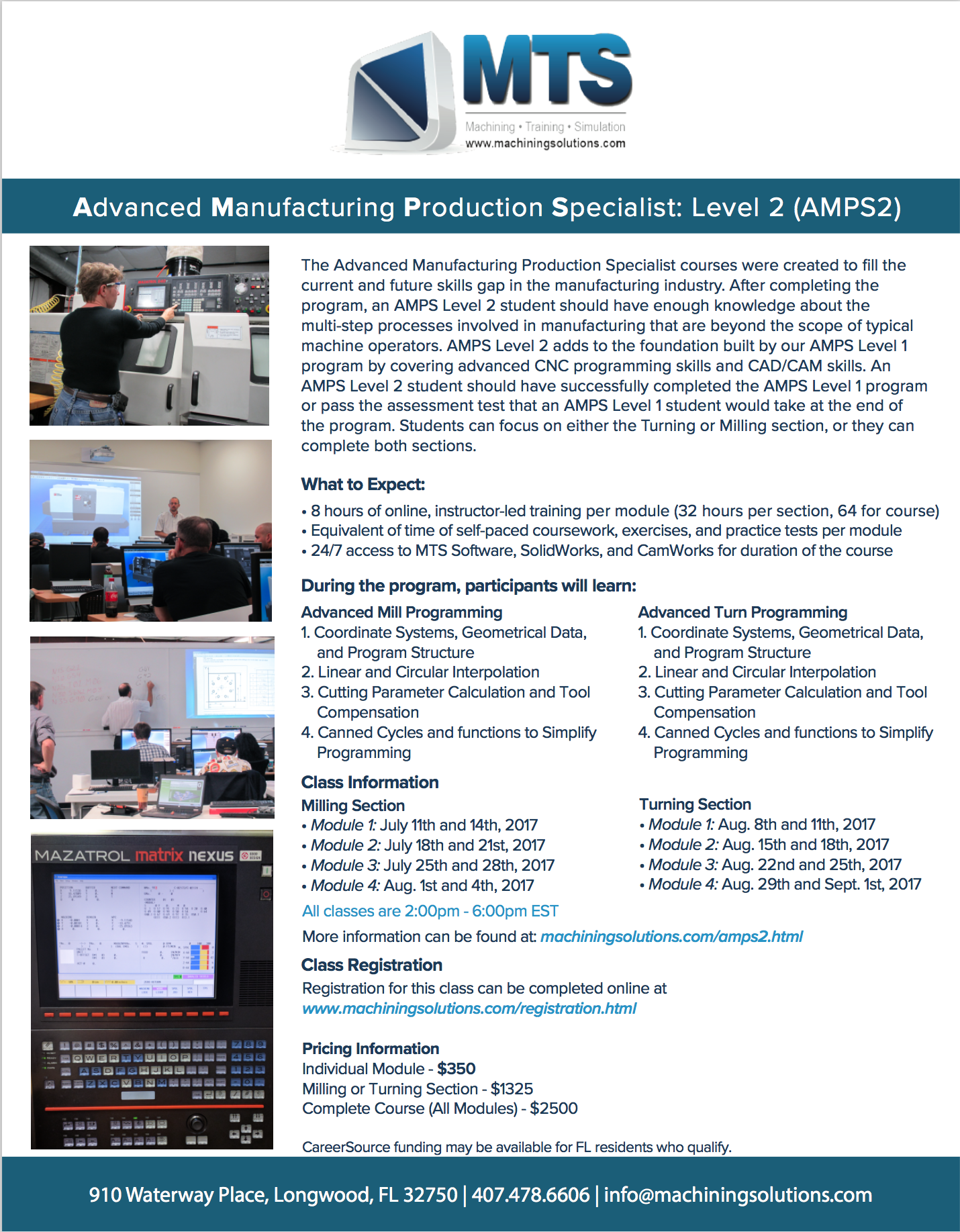Advanced Manufacturing Production Specialist
Level 2
The Advanced Manufacturing Production Specialist courses were created to fill the current and future skills gap in the manufacturing industry. After completing the program, an AMPS Level 2 student should have enough knowledge about the multi-step processes involved in manufacturing that are beyond the scope of typical machine operators. AMPS Level 2 adds to the foundation built by our AMPS Level 1 program by covering advanced CNC programming skills and CAD/CAM skills. An AMPS Level 2 student should have successfully completed the AMPS Level 1 program or pass the assessment test that an AMPS Level 1 student would take at the end of the program. Students can focus on either the Turning or Milling section, or they can complete both sections.
Upcoming Class Dates
| Milling Module 1: July 11th and 14th, 2017 from 2:00pm - 6:00pm EST | Turning Module 1: August 8th and 11th, 2017 from 2:00pm - 6:00pm EST |
| Milling Module 2: July 18th and 21st, 2017 from 2:00pm - 6:00pm EST | Turning Module 2: August 15th and 18th, 2017 from 2:00pm - 6:00pm EST |
| Milling Module 3: July 25th and 28th, 2017 from 2:00pm - 6:00pm EST | Turning Module 3: August 22nd and 25th, 2017 from 2:00pm - 6:00pm EST |
| Milling Module 4: August 1st and 4th, 2017 from 2:00pm - 6:00pm EST | Turning Module 4: August 29th and September 1st, 2017 from 2:00pm - 6:00pm EST |
Milling Modules
- Module 1: The use of Cartesian and Polar coordinate systems and how they apply to CNC milling. Machine and workpiece coordinate systems, tool geometrical data (common milling tools), and explanation of the NC program and structure.
- Module 2: Rules, language, and theory related to positioning of the tool, and linear and circular movement (interpolation) with optional radial address statements.
- Module 3: Proper tool call statement with cutting parameter calculation. Options for reference return, feed rate call, RPM (revolutions per minute) call, and tool radius compensation. Common machine switching functions (M Codes) are also covered.
- Module 4: Point machining using canned cycle functions to simplify programming, including: angular movement, corner rounding and chamfering, mirror and scale function, and coordinate rotation.
Turning Modules
- Module 1: The use of Cartesian and Polar coordinate systems and hopw they apply to CNC turning. Machine and workpiece coordinate systems, tool geometrical data (common turning tools), and explanation of the NC program structure.
- Module 2: Rules, language, theory related to positioning the too, and linear and circular movement (interpolation) with optional radial address statements.
- Module 3: Proper tool call statement with cutting parameter calculation. Options for reference return, feed rate call, RPM (revolutions per minute) call, constant surface speed use, and tool nose radius compensation. Common machine switching functions (M Codes) are also covered.
- Module 4: Cycles for cross and straight rough turning, finish turning, thread turning, and functions to simplify programming, including: angular movement, corner rounding, and chamfering.

Download Flyer |



